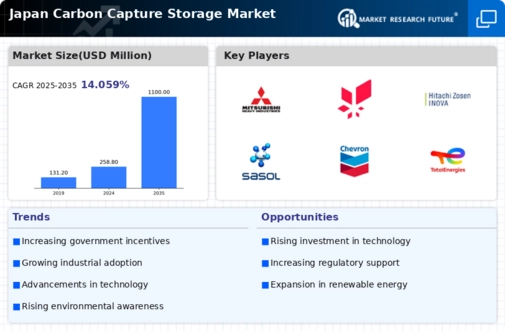Public-Private Partnerships
Public-private partnerships (PPPs) are emerging as a crucial driver for the carbon capture-storage market in Japan. The government is increasingly recognizing the importance of collaboration with private entities to achieve its climate objectives. By leveraging private sector expertise and investment, the government can enhance the efficiency and effectiveness of carbon capture projects. Recent initiatives have seen the establishment of joint ventures between public institutions and private companies, aimed at developing large-scale carbon capture facilities. These partnerships not only facilitate funding but also promote the sharing of best practices and technologies. As a result, the carbon capture-storage market is likely to benefit from accelerated project implementation and innovation, ultimately contributing to Japan's climate goals.
Corporate Sustainability Goals
Many corporations in Japan are increasingly adopting sustainability goals that align with the carbon capture-storage market. A growing number of companies are committing to achieving net-zero emissions by 2050, which necessitates the integration of carbon capture technologies into their operations. This trend is particularly pronounced in energy-intensive industries such as manufacturing and transportation, where emissions reduction is critical. As businesses strive to meet these ambitious targets, the demand for carbon capture solutions is likely to surge. Reports indicate that companies investing in carbon capture technologies could see a return on investment through enhanced brand reputation and compliance with emerging regulations, thereby driving growth in the carbon capture-storage market.
Regulatory Framework Enhancements
The regulatory landscape in Japan is evolving to support the carbon capture-storage market. The government has introduced stringent emissions reduction targets, aiming for a 46% reduction in greenhouse gas emissions by 2030 compared to 2013 levels. This regulatory push is likely to create a favorable environment for investments in carbon capture technologies. Furthermore, the establishment of clear guidelines and incentives for carbon capture projects may encourage private sector participation. As a result, companies are increasingly exploring carbon capture solutions to comply with regulations, thereby driving growth in the carbon capture-storage market. The anticipated increase in compliance costs for non-adopters could further incentivize businesses to invest in carbon capture technologies, potentially leading to a more robust market framework in the coming years.
Investment in Research and Development
Japan's commitment to innovation is evident in its substantial investments in research and development (R&D) for carbon capture technologies. The government has allocated approximately $1 billion for R&D initiatives aimed at enhancing carbon capture efficiency and reducing costs. This financial commitment is expected to stimulate advancements in the carbon capture-storage market, making technologies more accessible and economically viable. Collaborations between public institutions and private enterprises are likely to foster innovative solutions, potentially leading to breakthroughs in carbon capture methods. As these technologies mature, they may attract further investments, thereby expanding the market and enhancing Japan's position as a leader in carbon capture solutions.
International Collaboration and Partnerships
Japan is actively engaging in international collaborations to advance the carbon capture-storage market. Partnerships with countries that have established carbon capture initiatives can facilitate knowledge transfer and technology sharing. For instance, Japan's involvement in international forums and agreements, such as the Paris Agreement, underscores its commitment to global climate goals. These collaborations may lead to joint ventures that enhance the development and deployment of carbon capture technologies. Additionally, access to international funding and expertise could accelerate the commercialization of innovative solutions in Japan, potentially positioning the country as a hub for carbon capture advancements in the Asia-Pacific region.

















Leave a Comment